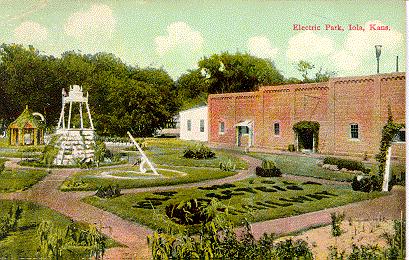Iola Electric Park
Iola, Allen County, KS
by Ralph Decker, Jr.
| Date Opened: 1902? Date Closed: 1918? Location: One mile east of Iola near where present-day U.S. 54 crosses Rock Creek Remains at site: None Trolley Park: Yes |

| Beginnings In 1871 drillers struck natural gas near Iola while drilling for oil. Further explorations for natural gas took place in the ensuing years and in 1893 the first of several major wells "came in." Soon a move was on to entice the zinc-smelting industry to relocate from nearby Pittsburg, Kansas, to Allen County. With an offer of free natural gas to power the plants, there were soon seven in operation. Brick plants and a cement plant were also built in the area. In 1900 a Mr. Frank V. Crouch of Carrolton, Missouri, saw the opportunity to establish an electric interurban railroad to transport the many workers in the Iola area. He moved to town, promoted his plan locally and persuaded Saint Louis capitalists to back him. Construction of the electric line began May 23, 1901, and the first cars ran December 24 of that year. On December 27, 1901, it was announced that Mr. Crouch was seeking a site along the route for an amusement park. Negotiations for land on the Neosho River at the western end of the line failed. It was then decided to occupy a thirty-acre plot on Rock Creek, about a mile east Iola. Modeled after Electric Park in Kansas City, Missouri, the park would be adjacent to the powerhouse/car barn of the interurban. The side of that structure is visible in the post card reproduced above. L. M. Boyer was appointed park manager. When the park actually opened seems somewhat obscure as does of list of amusements available at the time. Various accounts suggest that the summer of 1902 saw some use of the location, possibly as little more than a picnic ground. By 1904 the Iola Daily Register contains advertisements announcing a carnival at the park. The year 1906 seems to have been the heyday of the park, with a full complement of amusements available at that time. On July 4, 1906, alone, 30,000 persons rode the interurban to the park and soon talks were underway to make the park a stop on the Chautauqua circuit. In 1907 250,000 admissions to the park were collected.
|
| Rides and attractions The entrance to the park had beautifully landscaped gardens. Additionally, these diversions were available in the park at its peak:
No description or pictures of the "water toboggan" seem to exist. However, according to volunteers at the Allen County Historical Society their parents had described it as a chute-the-chute. The laughing gallery was presumably a fun house.
|
Remains By the end of 1909 the gas wells which had brought industry to the Iola area began to fizzle and the first smelter closure took place. In 1910 five more smelters closed and the industrial base of Allen County began to diminish. The Iola Electric Railway soldiered on, but on March 21, 1919, the order was given to close down the line. There appears to be no report of the closing of the park but one may assume that it did not outlast the interurban, its parent company. The site was later used for a greenhouse operation and a new highway is now (1999) under construction in the area. That construction seems to have erased any hope of finding remnants of the park.
|
Resources & References
|
Article © Ralph Decker, Jr.
All material on this page was provided courtesy of Ralph Decker, Jr.
Used with permission.
Defunct Amusement Parks wishes to thank him for the use of this material.
© 1999 Joel W Styer unless
otherwise noted. All rights reserved. Updated Wednesday, February 18, 2004